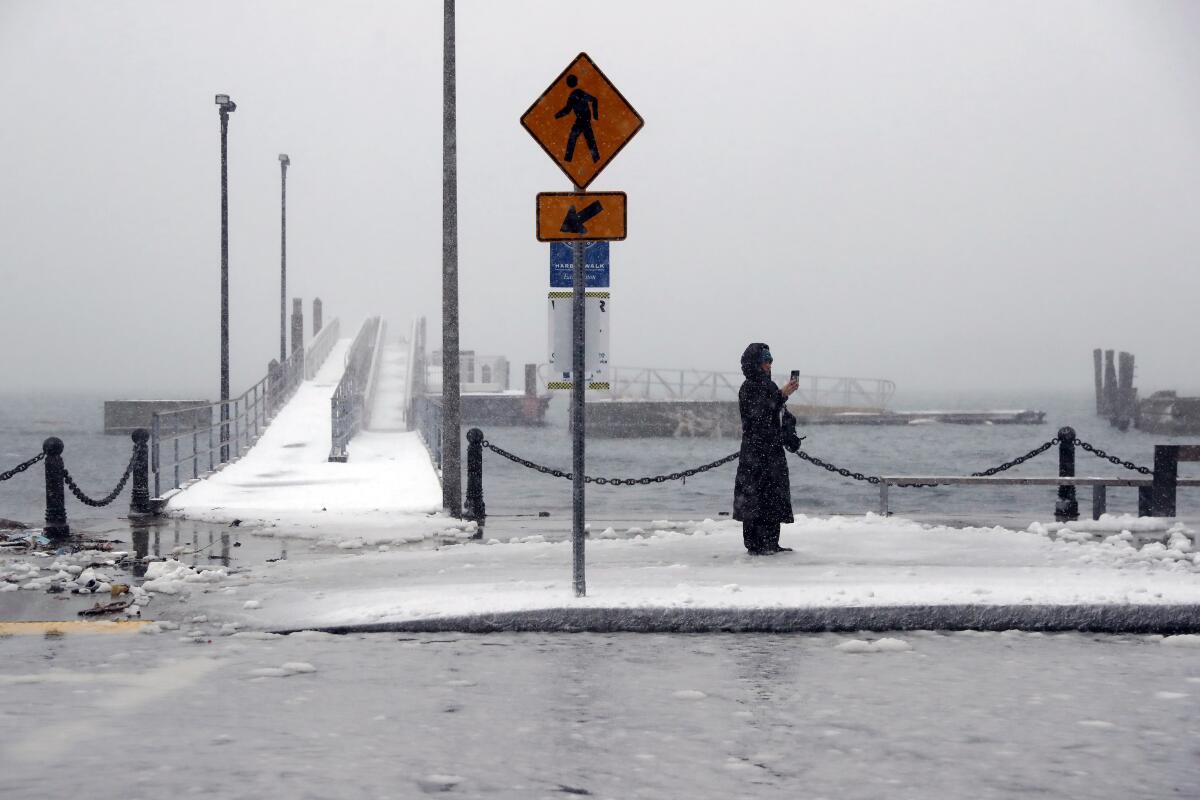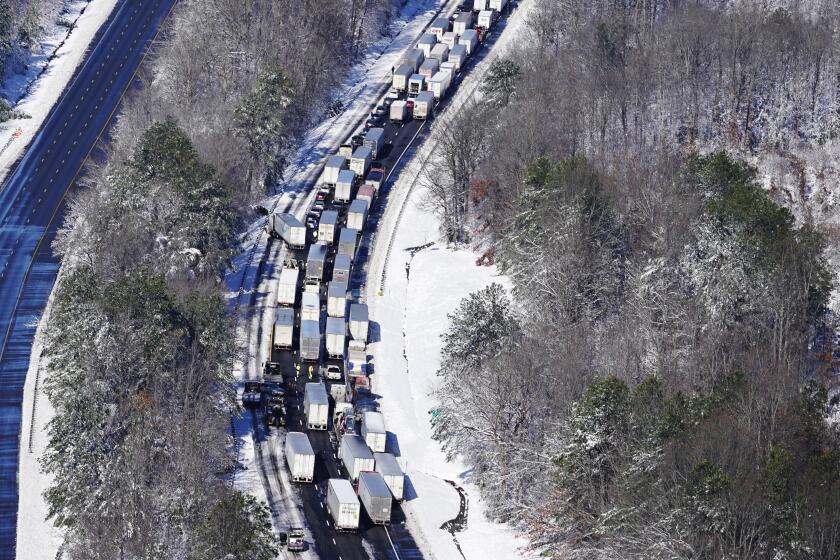Blizzard buffets East Coast with deep snow, winds and flooding

- Share via
BOSTON — A nor’easter with hurricane-force wind gusts battered much of the East Coast on Saturday, flinging heavy snow that made travel treacherous or impossible, flooding coastlines, and threatening to leave bitter cold in its wake.
The storm thrashed parts of 10 states, with blizzard warnings stretching from Virginia to Maine.
Philadelphia and New York saw plenty of wind and snow, but Boston was in the storm’s crosshairs. The city was poised to see over 2 feet of snow by early Sunday, when the storm was expected to move out.
Winds gusted as high as 83 mph on Cape Cod, Mass. Southwest of Boston, the town of Sharon, Mass., had received more than 30 inches of snow by Saturday night, while Islip, N.Y., and Warren, R.I., both saw more than 24 inches. Over 22 inches had fallen by midafternoon on part of Long Island in New York.
The wind scoured the ground bare in some spots and piled the snow into huge drifts in others.
Forecasters watched for new snowfall records, especially in Boston. The Boston area’s modern snowfall record is 27.6 inches, set in 2003.
New York City and Philadelphia were far from setting all-time records but still saw significant snowfall, with at least 7.5 inches in New York’s Central Park and at the Philadelphia airport.
Most flights at airports serving New York, Boston and Philadelphia were canceled Saturday, according to FlightAware. Over 4,500 flights were canceled across the country. Amtrak canceled high-speed Acela train service between Boston and Washington, and canceled or limited other service.
Across the region, residents hunkered down to avoid whiteout conditions and stinging snow hurled by fierce winds. Businesses opened late — or not at all.
In suburban Boston, a bundled-up Nicky Brown, 34, stood at the doors of Gordon’s liquor store in Waltham on Saturday, waiting for it to open.
“My boyfriend is out driving a plow, and I had a bunch of cleaning to do at home, and I want a drink while I’m doing it,” she said as she called another store to find out if it was open. “It’s a good day to stay inside and clean.”
Video on social media from elsewhere in Massachusetts showed wind and waves battering Quincy and Weymouth, south of Boston, flooding streets with a slurry of frigid water. Other video showed a street underwater on Nantucket and waves crashing against a building’s windows in Plymouth.
Over 120,000 homes and businesses had lost power in Massachusetts by Saturday evening. No other states reported widespread outages.
Climate change, particularly the warming ocean, probably influenced the strength of the storm, atmospheric researchers said.
Much-warmer ocean waters “are certainly playing a role in the strengthening of the storm system and increased moisture available for the storm,” said Jason Furtado, a meteorology professor at the University of Oklahoma. “But it isn’t the only thing.”
The storm had two saving graces: Its dry snow was unlikely to snap trees and tear down power lines, and its timing on a weekend meant schools were closed and fewer people were commuting to work.
Blizzard warnings were in effect in parts of Maine, New Hampshire, Massachusetts, Rhode Island, Connecticut, New York and New Jersey, along with much of the Delmarva Peninsula, which is shared by Delaware, Maryland and Virginia. Officials in those 10 states warned people to stay off the roads.
The National Weather Service considers a storm a blizzard if it has snowfall or blowing snow and winds of at least 35 mph that reduce visibility to a quarter-mile or less for at least three hours. In many areas, Saturday’s storm met those criteria.
Rhode Island, which was under a statewide blizzard warning, banned all nonemergency road travel.
In West Hartford, Conn., a tractor-trailer jackknifed on Interstate 84, closing several lanes. Massachusetts banned heavy trucks from interstate highways.
New York Gov. Kathy Hochul advised people to stay home and warned that below-zero wind chills could follow the storm. The state had declared a state of emergency Friday evening.
“This is a very serious storm.... We’ve been preparing for this. This could be life-threatening,” Hochul said. “It’s high winds, heavy snow, blizzard conditions — all the elements of a classic nor’easter.”
Long Island police reported that motorists were becoming stuck in the snow and that an elderly man had died after falling into a swimming pool while shoveling snow.
In Philadelphia, where 6 inches of snow had fallen by early Saturday, few drivers ventured onto streets covered in knee-high drifts.
Authorities had announced that all stranded motorists had made it off a 40-mile stretch of Interstate 95 south of Washington, D.C.
Ocean City, Md., saw at least a foot of snow. Maryland State Police tweeted that troopers had received more than 670 calls for service and responded to over 90 crashes by midmorning.
Many took the storm in stride.
Hundreds of New Yorkers joined a mass snowball fight Saturday in Greenwich Village’s Washington Square Park.
And Dave McGillivray, race director for the Boston Marathon, jokingly invited the public to his suburban Boston home on Saturday for a free snow shoveling clinic.
“I will provide the driveway and multiple walkways to ensure your training is conducted in the most lifelike situation,” he said.
Washington and Baltimore got some snow but were largely spared. The worst of the nor’easter was expected to pass by Sunday morning and blow into Canada, where several provinces were under warnings.
Catalini reported from Morrisville, Pa. Associated Press video journalist Rodrique Ngowi in Boston and writers David Collins in Hartford, Conn.; Jeff McMillan in Scranton, Pa.; and Ron Todt in Philadelphia contributed to this report.
More to Read
Sign up for Essential California
The most important California stories and recommendations in your inbox every morning.
You may occasionally receive promotional content from the Los Angeles Times.














